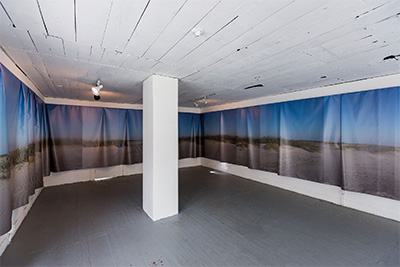JooYoung Choi, Have Faith For You Have Always Been Loved, 2016, Installation View.
Photos by Alex Barber.

Round 45: Local Impact at Project Row Houses through Feb. 12, includes artists Regina Agu, JooYoung Choi, Sally Glass, Jesse Lott + Ann Harithas, Tierney Malone, Harold Mendez, and Patrick Renner. While this round is not explicitly thematic, there are some running motifs that can be seen throughout the houses. Many of these artists deal with issues of histories, real and imagined, healing processes and identity. With this said, the aesthetic diversity of all the installations was impressive, starting with Agu’s piece embracing the Gulf Coast aesthetic, Sally Glass’s minimalist multi-media exploration of technology and the self, Patrick Renner’s participatory sound work, and Harold Mendez’s industrial search for identity. But most striking about this round was not the diversity of aesthetics, but the diversity in curatorial approach. Some of the houses opted for a traditional gallery layout, others resembled museums and some removed themselves entirely from institutional tradition.
Walking down Holman St., visitors first encounter The Jazz Church of Houston, curated by Malone. Dedicated to the history of jazz in Houston, Malone has covered the walls in historic photographs, album covers, newspaper articles and sheet music. Featuring local legends such as Arnette Cobb and Redd Fox, Malone has traced the often forgotten history of Houston’s jazz scene and its cultural and sociopolitical significance to the Black community. This “museum” by day transforms into a music venue at night with performances by local jazz musicians including pianist Harry Darraugh.

At 2505, Jesse Lott and Ann Harithas have put together a curated selection of their collages. While their work is certainly quite similar, drawing inspiration from artists like Mel Chin, Salvatore Scarpitta, and Travis Whitfield, formally they are quite different each drawing inspiration from their childhoods and formal education. The house is arranged in a traditional gallery layout with gold and silver alternating frames lining the walls. Harithas’s work, all framed in gold, incorporate images of longhorns, cowboys and southern landscapes, all familiar scenes from her childhood in Victoria, Texas where she visited her family’s ranch. She seamlessly merges these pictures, cut from magazines, to create uniquely Texan scenes. Lott’s work is equally autobiographical, but manifests quite differently with a more abstract, sometimes cubist aesthetic. Layering color and texture he creates an abstract world of forms that force the viewer to engage with the objects purely as pattern. Lott describes early memories of collecting firewood as a child and seeing form and imagery in the wood grain. This notion of creating of form out of texture is one that is still very present in his work and contrasts beautifully with Harithas’ more representational style.
JooYoung’s Choi’s piece, Have Faith For You Have Always Been Loved, the most elaborate installation of the seven houses, tells the story of a crash- landing on Earth by captain Spacia Tanno and Noi-Ro the Infinite. Desperate for help and in dire need of “constellation plasma,” the two await an attack from General Orion #486 and his army of Onroids. To introduce us to this fantastical story and its characters, JooYoung divides the house into two rooms with the first providing the context and the second inviting viewers to meet Captain Spacia Tanno and Noi-Ro in a moment of grief. In the “makers space”, as she captions the room in brightly colored paper letters, she has covered the walls in her plans and proposals for the house. Not only are visitors able to view the process by which she created the story, but also engage with Choi’s artistic process as she organized all of her materials in perfectly labeled containers around the room.

Passing through a curtained door, viewers encounter a darkened, black lit space illuminating two larger than life felt sculptures sitting in a mystical forest. Depicted is a wounded Noi-Ro in the arms of Spacia Tanno. Tears, or potentially healing energy, flow from his eyes and encircle Noi-Ro. Viewers are asked to help heal the wounded warrior and donate “constellation plasma” by writing down the name of someone who taught them how to love on the bottom of small electric candles. The intricacies of the story and participation are, for JooYoung, healing themselves as she utilizes science fiction and fantasy to create a space for revitalization.
The immense formal and thematic variation between the houses in Local Impact allows for viewers to ruminate over the importance of spaces like Project Row Houses for local artistic communities. In these houses we see important processes taking place, open for the public. We encounter explorations of untold histories, fantastic methods of self-care and healing, the detrimental effects of tourism on the environment, and even how the institutions within which we see works of art affect how we connect with them.
—EMILIA DUNO

